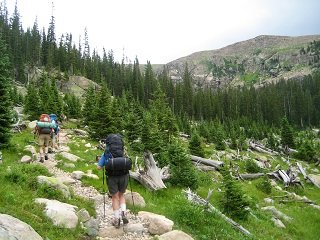 While many find casual trips to their local trails to be rich with leisure, many of the trails in the country are not to be taken lightly. Some hikes are rigorous enough—rocky terrain and steep climbs are demanding—but when you add to the equation a full pack, your body will be pushed to new limits. If you’re not prepared, this can quickly lead to fatigue or soreness. Today, I’ve provided you with a few tips on how to condition your body for backpacking so that you can spend more time hiking and less time taking breaks.
While many find casual trips to their local trails to be rich with leisure, many of the trails in the country are not to be taken lightly. Some hikes are rigorous enough—rocky terrain and steep climbs are demanding—but when you add to the equation a full pack, your body will be pushed to new limits. If you’re not prepared, this can quickly lead to fatigue or soreness. Today, I’ve provided you with a few tips on how to condition your body for backpacking so that you can spend more time hiking and less time taking breaks.
The best way to build your muscle strength is to get up and move. Start with shorter, less strenuous hikes, minimal elevation, and a light backpack. After some time, gradually increase the duration and elevation of your hikes and increase your backpack load. As your lower body strength increases and you improve your endurance, switch to longer, more challenging hikes. Loading your backpack with the gear and weight you are most likely to carry will help you become familiar with conditions you will face deep in the backcountry, as well.
If you don’t have direct access to a trail, the gym is the next best thing. Stair-steppers, elliptical trainers and climbing machines provide a great cardiovascular and strength training work out, and they isolate your lower-body muscle groups and help build endurance. Also, a consistent, diversified weight-resistance program helps prepare muscle groups all over your body for the sudden introduction to the full-time, all-day physical activity of hiking in the backcountry, which is great because trained muscles are less susceptible to injury and strains.
Finally, you can condition your body around your house, as well. Take the stairs whenever possible, whether at home or at the mall. Walking or running up and down them on a regular basis is great pre-trail training. You can even mimic step aerobics by just running up one step and then back down, and then repeating the motion. If you can perform certain routine chores by leaving your car keys in your pocket, do it. Walk to the library, the park or the store if you can, and for added conditioning, wear a backpack.
Your current physical condition will determine how much training you’ll need before you start backpacking more frequently, but it never hurts to prepare. Don’t over-do it, but try to commit to at least 30 minutes a few days a week, and you’ll see a definite change in your fitness level. The backcountry, while beautiful, relaxing, and serene, is no cake walk. Implement the tips outlined above in some form of a training routine for yourself and you’ll find more enjoyment when you hit the trails this season.








